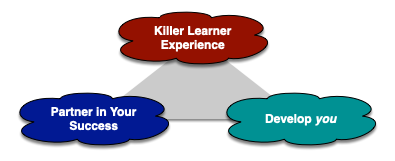The initial Learning 3.0 conference (well-done, Phillip, Julie, & Leah) was held in conjunction with The Motivation Show, a large conference (dwarfing our little group) and Expo on incentive and recognition programs. And it’s thought-provoking.
First, you have to know that while I understand sales commissions and rewards, because they *work*, I don’t like them. It seems to me to be rewarding a behavior of convincing people to buy things they might not otherwise do. And, yes, I know that there’s a move to solution selling (through one of my partners I’ve done a fair bit of work on sales), but still, solution selling hasn’t always worked (partly because it often isn’t implemented well: e.g. the incentives are still aligned with product selling).
So you can imagine my reaction as I walked the motivation expo hall on the last day. Aisle after aisle of vacation destinations, gourmet foods, luxury items, and more. It would’ve been a great shopping experience if you were well-heeled and this wasn’t focused on corporate buyers.
And I became curious. We’d heard that there are incentives for many things: health, safety, and more. I’d heard of rewarding innovation. I wondered if, as I cynically believed, this was largely for sales rewards instead of those other things. And while I couldn’t get the answer as clearly as I wanted, it wasn’t as bad as I’d thought.
What I found was that sales was something less than a quarter, consumer promotions roughly a quarter, business gifts roughly another quarter, and employee recognition rounded out the last quarter. So, 70-75% or so was on the transaction side and the rest was for employees. Moreover, talking to one of the recogntion system vendors, it became clear that this trend was new; that sales *had dominated, but they were moving to recognizing that this could apply more broadly (tho one of the venue folks noted that the show had shrunk from years before).
And I think it makes sense. Look, there are product and service designers working to come out with new and better products that better serve the market, and increase sales. And, as one of the attendees I shared lunch with noted, if the learning group offers improved sales training and product training, and it creates a delta in sales, why don’t they get a share?
Now, this whole incentive ‘motivation’ thing is “gamification”. They’re creating simple reward things that increase behaviors, but they’re extrinsic, not intrinsic (cf the distinction between gamification and what I call engagification). And, as Dan Pink’s “Drive” says (as did the keynote by the former CEO of Texas RoadHouse), intrinsic awards work better.
I think I’ll stand by my belief that sales incentives can end up creating a situation where people are rewarded for getting people to do things that they’re not inclined to do. And while some may argue that it is in the best interest (e.g. getting people to be safe, or exercise, or eat better, which I’d argue folks largely would like to do), in general I reckon most folks wouldn’t like to buy things that they might not otherwise purchase. And for those who think I’m being too harsh on sales, let me ask what they think would happen if those incentives went away and sales folks were on salary only. Would you have happier consumers?
Look, I’m still happy to do the best I can to make sales training and product skills the best it can be (and I’ll suggest that the design principles I espouse will do that as well as it can be done), because it is largely independent of the rewards structure. I just want that, as a society, we might want to look at the tradeoffs. When teachers impact society in more important ways (granted, in my opinion), I think we might want to be looking at increasing their performance more than sales folks. Reckon?
 An absolutely killer learning experience
An absolutely killer learning experience